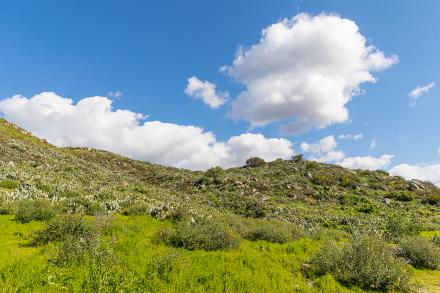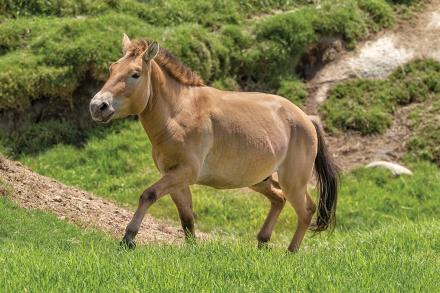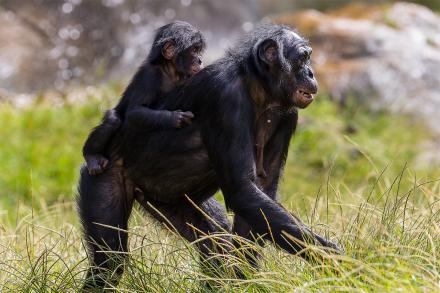
There’s an important part of the San Diego Zoo Safari Park that most guests never see. The Biodiversity Reserve encompasses and protects about 1,000 acres of native coastal sage scrub and chaparral habitat. It’s one of the largest remaining expanses of this type of landscape in the region and is located at the intersection of two critical wildlife corridors. While the rest of the Safari Park is known for sprawling savannas and other immersive habitats from around the globe, this wilderness is home to wildlife we save, protect, and care for right here through our Southwest Conservation Hub.
San Diego County is the most biodiverse county in the contiguous United States, with extraordinarily high numbers of plant and animal species. The Biodiversity Reserve alone provides support for 179 bird, 24 mammal, 28 reptile, and 4 amphibian species. Unfortunately, as San Diego County is also a biodiversity hotspot, much of this wildlife is threatened.
To protect local flora and fauna, our conservation scientists are working to better understand how resident and migratory animals use this vital landscape. They’re also developing effective monitoring techniques and studying new methods to foster coexistence with mountain lions and other local wildlife. Read on to discover more about the incredible work happening every day in this one-of-a-kind place.

Cactus wrens rely on prickly pear cactuses for nesting—and this crucial plant thrives in the Biodiversity Reserve.
HOME IN THE CACTUS
Found only in Southern California, coastal cactus wrens are at risk due to disappearing cactus scrub habitat. Most of the remaining population in San Diego County relies on cactus scrub in the San Pasqual Valley, where the Safari Park is located.
Our Plant Conservation team has been diligently restoring and enhancing vegetation in this critical area. By planting prickly pear cactus in the Biodiversity Reserve, they’ve been able to increase the number of healthy cactuses available for nesting, giving the wrens a better chance at a flourishing future. These efforts are now informing ongoing restoration projects in other areas of Southern California.

We’re using trail cameras and GPS monitoring to learn more about mountain lions in the Biodiversity Reserve—and using that knowledge to inform future conservation efforts.
COUGAR VISION
While they’re not yet categorized as endangered, mountain lions face serious threats from urbanization and habitat fragmentation, which have dramatically reduced their numbers. We’re using trail cameras and GPS monitoring to learn more about mountain lions in the Biodiversity Reserve. That knowledge helps inform larger conservation programs that foster coexistence with people, pets, and livestock.
Together with our partners, we’re working to address current threats to these cats and develop noninvasive deterrents. Solutions include noises and lights that are neutral to people and domestic animals, but cause mountain lions to avoid specific areas.

New technology allows us to monitor the movement of red diamond rattlesnakes in the Biodiversity Reserve, gaining insight into their behaviors and their relationship with other wildlife.
DIAMOND LIFE
The red diamond rattlesnake has one of the smallest ranges of any rattlesnake in the U.S., and the Biodiversity Reserve is a hotspot for this species. These snakes are important ambush predators in their ecosystem. This also makes them elusive, and historically red diamond rattlesnakes have been difficult to study.
We’re collaborating with partners on a new way to study these snakes in the Biodiversity Reserve using accelerometers. These noninvasive transmitters are attached to the base of a snake’s rattle, which is at the end of their body. The devices can provide up to 75 data points per second on the snake’s movements, direction, speed, and location. Using machine learning technology, the accelerometer data patterns are used to assemble a behavior profile of each snake. These insights are helping scientists better understand the red diamond rattlesnake’s relationship with other wildlife and learn more about their conservation needs so that we can protect the species.

The Biodiversity Reserve’s coastal sage scrub is an important habitat for a wide array of wildlife—including plants like the prickly pear cactus, which provides food for many species and nesting spots for cactus wrens.
FOR THE FUTURE
This year, the Biodiversity Reserve was officially designated as a protected space by 30×30 California. This is a state- and community-driven initiative with the goal of protecting 30 percent of California’s lands and coastal waters by 2030. It’s aligned with national and international goals to preserve biodiversity and connect people to nature around the globe.
The 30×30 California initiative encourages conservation organizations, community groups, land trusts, and indigenous peoples to work together to help restore balance in our ecosystems and help mitigate climate change. San Diego Zoo Wildlife Alliance is participating in the San Diego Regional Group and working with our conservation partners to promote biodiversity, protect ecosystems, and encourage access to nature for all.
The Biodiversity Reserve’s inclusion in 30×30 California strengthens climate resilience in several ways. By keeping this natural coastal sage scrub ecosystem from being developed, we’re preserving biodiversity as we safeguard a unique blend of habitats and species. And we’re offering community benefits by serving as a “living laboratory” for scientific research and conservation projects, enriching educational and research opportunities, and fostering deeper community engagement with nature conservation.

In addition to the Biodiversity Reserve, the undeveloped Descanso Ranchland (also known as Samataguma Ranch) managed by San Diego Zoo Wildlife Alliance has been designated as a protected space by 30×30 California.
Another area we manage—the Descanso Ranchland (also known as the Samataguma Ranch by Indigenous communities)—has also been designated as a protected space by 30×30 California. It encompasses nearly 700 acres of undeveloped land and chaparral vegetation located in the Cuyamaca Mountains of southeastern San Diego County. Like the Biodiversity Reserve, this natural landscape is home to diverse wildlife and serves as a field research laboratory for conservation science. Here we gain greater insights on restoration and preservation of native species and habitats, as well as how to restore balance to ecosystems.
OUR SOUTHWEST CONSERVATION HUB
We look forward to a bright future as we work together to preserve local wildlife and ecosystems through these partnerships across our Southwest Conservation Hub. As an Alliance, we know that we can accomplish so much more when we work together. With allies like you by our side, vital conservation work happens each and every day—within the Biodiversity Reserve and Descanso Ranchland, throughout the San Diego Zoo and San Diego Zoo Safari Park, and across all eight of our Conservation Hubs around the globe.



